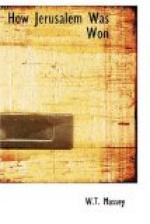[Footnote 1: See Appendix v].
CHAPTER V
RAILWAYS, ROADS, AND THE BASE
To ease the supply problem a spur line was laid from Rafa to Shellal, on the wadi Ghuzze. In that way supplies, stores, and ammunition were taken up to our right flank. Shellal was a position of great strategic importance. At one time it appeared as if we should have to fight hard to gain it. The Turks had cut an elaborate series of trenches on Wali Sheikh Nuran, a hill covering Shellal, but they evacuated this position before we made the first attack on Gaza, and left an invaluable water supply in our hands.
At Shellal the stony bed of the wadi Ghuzze rests between high mud banks which have been cut into fantastic shapes by the rushing waters descending from the southern extremities of the Judean range of hills during the winter rains. In the summer months, when the remainder of the wadi bed is dry, there are bubbling springs of good water at Shellal, and these have probably been continuously flowing for many centuries, for close above the spot where the water issues Anzac cavalry discovered a beautiful remnant of the mosaic flooring of an ancient Christian church, which, raised on a hundred-feet mound, was doubtless the centre of a colony of Christians, hundreds of years before Crusaders were attracted to the Holy Land. Our engineers harnessed that precious flow. A dam was put across the wadi bed and at least a million gallons of crystal water were held up by it, whilst the overflow went into shallow pools fringed with grass (a delightfully refreshing sight in that arid country) from which horses were watered. Pumping sets were installed at the reservoir and pipes were laid towards Karm, and from these the Camel Transport Corps were to fill fanatis—eight to twelve gallon tanks—for carriage of water to troops on the move.
The railway staff, the department which arranged the making up and running of trains, as well as the construction staff, had heavy responsibilities. It was recognised early in 1917 that if we were to crush the Turk out of the war, provision would have to be made for a larger army than a single line from the Suez Canal could feed. It was decided to double the track. The difficulties of the Director of Railway Transport were enormous. There was great shortage of railway material all over the world. Some very valuable cargoes were lost through enemy action at sea, and we had to call for more from different centres, and England deprived herself of rolling stock she badly needed, to enable her flag of freedom to be carried (though it was not to be hoisted) through the Holy Land. And incidentally I may remark that, with the solitary exception of a dirty little piece of Red Ensign I saw flying in the native quarter in Jerusalem, the only British flag the people saw in Palestine and Syria was a miniature Union Jack carried on the Commander-in-Chief’s motor car and by his standard-bearer




